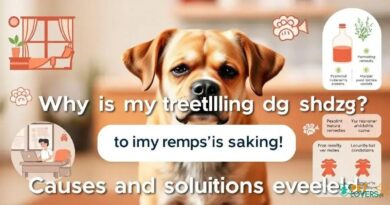What is canine anxiety solutions
Understanding Canine Anxiety
Canine anxiety refers to the emotional distress experienced by dogs in various situations, often leading to behaviors such as excessive barking, destructive chewing, or even aggression. This condition can stem from a variety of triggers, including loud noises, separation from their owners, or changes in their environment. Understanding the root causes of canine anxiety is crucial for effective treatment and management.
Common Symptoms of Canine Anxiety
Dogs suffering from anxiety may exhibit a range of symptoms that can vary in intensity. Common signs include panting, pacing, whining, and hiding. Some dogs may also engage in compulsive behaviors, such as licking or chewing themselves excessively. Recognizing these symptoms early can help pet owners take proactive steps to alleviate their dog’s distress.
Types of Canine Anxiety
There are several types of anxiety that dogs may experience, including separation anxiety, noise anxiety, and social anxiety. Separation anxiety occurs when a dog becomes overly attached to its owner and experiences distress when left alone. Noise anxiety is often triggered by loud sounds like thunderstorms or fireworks, while social anxiety can arise from negative experiences with other dogs or people.
Identifying Triggers of Canine Anxiety
Identifying the specific triggers of a dog’s anxiety is essential for developing an effective treatment plan. Common triggers can include changes in routine, new environments, or the presence of unfamiliar people or animals. Keeping a journal of your dog’s behaviors and reactions can help pinpoint these triggers and inform your approach to managing their anxiety.
Behavioral Solutions for Canine Anxiety
Behavioral solutions are often the first line of defense against canine anxiety. Techniques such as desensitization and counter-conditioning can help dogs gradually become accustomed to their triggers. For example, if a dog is anxious about loud noises, gradually exposing them to recorded sounds at a low volume while providing positive reinforcement can help reduce their fear over time.
Environmental Modifications for Anxiety Relief
Creating a safe and comforting environment can significantly reduce a dog’s anxiety levels. This may involve providing a designated quiet space where the dog can retreat during stressful situations. Additionally, using calming products such as anxiety wraps, pheromone diffusers, or soothing music can help create a more relaxed atmosphere for anxious dogs.
Natural Remedies for Canine Anxiety
Many pet owners seek natural remedies to help alleviate their dog’s anxiety. Herbal supplements, such as chamomile or valerian root, can promote relaxation. Additionally, CBD oil has gained popularity for its potential calming effects on dogs. However, it’s essential to consult with a veterinarian before introducing any new supplements to ensure they are safe and appropriate for your pet.
Professional Help for Severe Anxiety
In cases of severe anxiety, seeking professional help from a veterinarian or a certified animal behaviorist may be necessary. These professionals can provide tailored treatment plans that may include behavioral therapy, medication, or a combination of both. Early intervention is key to preventing anxiety from escalating and affecting a dog’s quality of life.
Training Techniques to Manage Canine Anxiety
Training techniques can also play a vital role in managing canine anxiety. Positive reinforcement training can help build a dog’s confidence and reduce anxiety-related behaviors. Teaching commands such as “sit” or “stay” can provide structure and reassurance, helping the dog feel more secure in their environment.
Long-Term Management of Canine Anxiety
Long-term management of canine anxiety often requires a multi-faceted approach that combines behavioral training, environmental modifications, and, if necessary, medication. Consistency and patience are crucial, as progress may take time. Regular check-ins with a veterinarian can help monitor the dog’s progress and adjust the treatment plan as needed.



